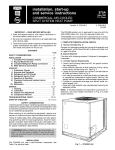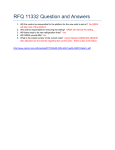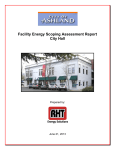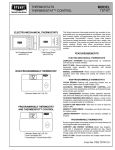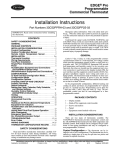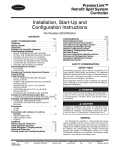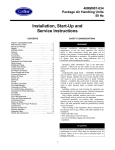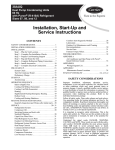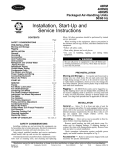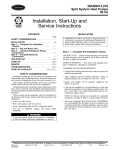Download Carrier AIR COOLED SPLIT SYSTEM 38AQS008 Specifications
Transcript
38AQS008 Air-Cooled Split System Heat Pump 50/60 Hz Installation, Start-Up and Service Instructions CONTENTS Page SAFETY CONSIDERATIONS . . . . . . . . . . . . . . . . . 1 INSTALLATION . . . . . . . . . . . . . . . . . . . . . . . . . . . . 1-9 Step 1 — Complete Pre-Installation Checks . . 1 • UNCRATE UNIT • INSPECT SHIPMENT • CONSIDER SYSTEM REQUIREMENTS Step 2 — Rig and Mount the Unit . . . . . . . . . . . . 2 • RIGGING • MOUNTING • COMPRESSOR MOUNTING Step 3 — Complete Refrigerant Piping Connections . . . . . . . . . . . . . . . . . . . . . . . . . . . . . 2 • SIZE REFRIGERANT LINES • FILTER DRIER AND MOISTURE INDICATOR • LIQUID LINE SOLENOID VALVE • SAFETY RELIEF • SUCTION PIPING AT INDOOR COIL AND TXV SENSING BULB LOCATION Step 4 — Make Electrical Connections . . . . . . . 3 • FIELD POWER SUPPLY • ACCESSORY ELECTRIC HEAT • FIELD CONTROL WIRING START-UP . . . . . . . . . . . . . . . . . . . . . . . . . . . . . . . 10,11 Preliminary Checks . . . . . . . . . . . . . . . . . . . . . . . . 10 Evacuate and Dehydrate . . . . . . . . . . . . . . . . . . . 10 Refrigerant Charge . . . . . . . . . . . . . . . . . . . . . . . . 10 Refrigerant Service Ports . . . . . . . . . . . . . . . . . . 10 Sequence of Operation . . . . . . . . . . . . . . . . . . . . 10 Checking Cooling and Heating Control Operation . . . . . . . . . . . . . . . . . . . . . . . . . . . . . . . 11 Malfunction . . . . . . . . . . . . . . . . . . . . . . . . . . . . . . . 11 SERVICE . . . . . . . . . . . . . . . . . . . . . . . . . . . . . . . . . 11-13 Cleaning . . . . . . . . . . . . . . . . . . . . . . . . . . . . . . . . . . 11 Lubrication . . . . . . . . . . . . . . . . . . . . . . . . . . . . . . . . 11 Outdoor-Fan Adjustment . . . . . . . . . . . . . . . . . . . 11 Compressor Removal . . . . . . . . . . . . . . . . . . . . . . 11 Cooling Mode Operation . . . . . . . . . . . . . . . . . . . 12 Heating Mode Operation . . . . . . . . . . . . . . . . . . . 12 TROUBLESHOOTING CHART . . . . . . . . . . . . . . 14,15 START-UP CHECKLIST . . . . . . . . . . . . . . . . CL-1,CL-2 Before installing or servicing system, always turn off main power to system. There may be more than one disconnect switch. Electrical shock can cause personal injury. INSTALLATION The 38AQS008 unit uses a semi-hermetic compressor. See Tables 1A and 1B for physical data. The 38AQS008 is approved by Carrier for use only with 40RMQ008 fan cooling units. Use only approved far coils. The 38AQS008 (60 Hz) is Underwriters’ Laboratories (UL) and Canadian Underwriters’ Laboratories (CUL) approved for use with the 40RMQ008 fan coil only. Step 1 — Complete Pre-Installation Checks UNCRATE UNIT (See Fig. 1) — Remove unit packaging except for the top skid assembly and wood bumpers, which should be left in place until after unit is rigged into place. INSPECT SHIPMENT — File claim with shipping company if shipment is damaged or incomplete. SAFETY CONSIDERATIONS Installing and servicing air-conditioning equipment can be hazardous due to system pressure and electrical components. Only trained and qualified service personnel should install or service air-conditioning equipment. When working on air-conditioning equipment, observe precautions in literature and on tags and labels attached to unit. Follow all safety codes. Wear safety glasses and work gloves. Use quenching cloth for brazing operations. Have fire extinguisher available. Read these instructions thoroughly. Consult local building codes and National Electrical Code U.S.A. (NEC) for special installation requirements. Fig. 1 — 38AQS008 Unit Manufacturer reserves the right to discontinue, or change at any time, specifications or designs without notice and without incurring obligations. Book 1 4 PC 111 Catalog No. 533-887 Printed in U.S.A. Form 38AQS-4SI Pg 1 6-95 Replaces: 38AQS-3SI Tab 5a 5a Table 1A — Physical Data (English) UNIT 38AQS008 OPERATING WEIGHT (lb) Aluminum Coils (Standard) Copper Coils (Optional) RIGGING WEIGHT (lb) Aluminum Coils (Standard) Copper Coils (Optional) REFRIGERANT* COMPRESSOR Quantity...Type Quantity Cylinders Speed (rpm) Oil Charge (oz) (ea) OUTDOOR FAN Quantity...rpm Diameter (in.) Motor Hp (NEMA) Nominal Airflow (cfm) OUTDOOR COIL Face Area (sq ft) Storage Capacity (lb)† Fins/in. Rows (No.) CONNECTIONS (Sweat) Suction (in.) Liquid (in.) CONTROLS Pressurestat Settings (psig) High Cutout Cut-in Low Cutout Cut-in Defrost Thermostat Initiate Defrost (F) Terminates Defrost (F) 60 Hz 50 Hz 540 608 594 662 590 658 644 712 Table 1B — Physical Data (SI) UNIT 38AQS008 OPERATING WEIGHT (kg) Aluminum Coils (Standard) Copper Coils (Optional) RIGGING WEIGHT (kg) Aluminum Coils (Standard) Copper Coils (Optional) REFRIGERANT* COMPRESSOR Quantity...Type Quantity Cylinders Speed (r/s) Oil Charge (L) (ea) OUTDOOR FAN Quantity...r/s Diameter (mm) Motor Hp (NEMA) Nominal Airflow (L/s) OUTDOOR COIL R-22 Reciprocating, Semi-Hermetic 1...06DA818 1...06DA824 4 6 1750 1460 88 128 Propeller; Direct Drive 1...1100 1...960 26 26 1⁄3 3⁄4 6500 6100 Enhanced Copper Tubes, Aluminum Lanced Fins 18.0 16.56 17.0 2 Face Area (m2) Storage Capacity (kg)† Fins/m Rows (No.) CONNECTIONS (Sweat)** Suction (in.) Liquid (in.) CONTROLS Pressurestat Settings (kPa) High Cutout Cut-in Low Cutout Cut-in Defrost Thermostat Initiate Defrost (C) Terminates Defrost (C) 1 1 ⁄8 1⁄2 426 320 7 22 ⫾ ⫾ ⫾ ⫾ 7 20 3 5 28 65 LEGEND NEMA — National Electrical Manufacturing Association (U.S.A.) *Unit is factory supplied with holding charge only. †Storage capacity of coil with coil 80% full of liquid R-22 at 120 F. 60 Hz 50 Hz 245 276 270 299 268 298 292 323 R-22 Reciprocating. Semi-Hermetic 1...06DA818 1...06DA824 4 6 29.2 24.2 2.60 3.78 Propeller; Direct Drive 1...18.3 1...16.0 660 660 1⁄3 3⁄4 3070 2900 Enhanced Copper Tubes, Aluminum Lanced Fins 1.67 7.5 669 2 11⁄8 1⁄2 2937 2206 48 151 ⫾ ⫾ ⫾ ⫾ 48 138 20 34 −2.2 18.3 LEGEND NEMA — National Electrical Manufacturing Association (U.S.A.) *Unit is factory supplied with holding charge only. †Storage capacity of coil with coil 80% full of liquid R-22 at 49 C. **All pipe sizes are OD inches; equivalent sizes in millimeters follow: in. mm 1⁄2 11⁄8 12.7 28.6 further protection for coil faces, plywood sheets may be placed against sides of unit, behind cables. Run cables to a central suspension point so that angle from the horizontal plane is not less than 45 degrees. Raise and set unit down carefully. If it is necessary to roll unit into position, mount unit on rails, using a minimum of 3 rollers. Apply force to rails, not unit. If unit is to be skidded into position, place it on a large pad and drag it by the pad. Do not apply any force to unit. Raise from above to lift unit from rails or pad when unit is in final position. After unit is in position, remove all shipping wrapping and top crating. MOUNTING — The unit must be elevated to ensure drainage from basepan during sub-freezing conditions and to prevent or limit blockage of outdoor coil during snowfall. Consideration should be given to specific geographical areas when determining height of unit elevation. COMPRESSOR MOUNTING — As shipped, compressors are held down by 4 bolts. After unit is installed, loosen each bolt until the snubber washer can be moved with finger pressure. See Fig. 4. CONSIDER SYSTEM REQUIREMENTS • Consult local building codes and NEC (U.S.A.) for special installation requirements. • Allow sufficient space for airflow clearance, wiring, refrigerant piping, and servicing unit. See Fig. 2. • Locate unit so that outdoor unit airflow is unrestricted on all sides and above. Refer to Fig. 2. • Unit may be mounted on a level pad directly on base rails or mounted on raised pads at support points. See Fig. 2 for weight distribution based on recommended support points. • Provide for condensate drainage and defrost water disposal beneath unit. • Areas with high snowfall may need elevated mounting for adequate airflow. NOTE: If vibration isolators are required for a particular installation, use corner weight information in Fig. 2 to make proper selection. Step 2 — Rig and Mount the Unit Be sure unit panels are securely in place prior to rigging. Step 3 — Complete Refrigerant Piping Connections — Suction connection is sweat with plastic cap; liq- RIGGING — These units are designed for overhead rigging. Refer to rigging label for preferred rigging method. Spreader bars are not required if top crating is left on unit. All panels must be in place when rigging. (See Fig. 3.) As uid connection is sweat with plastic cap. Refer to Table 2 for the proper line sizes. Follow standard piping practices. 2 Table 2 — Refrigerant Piping Sizes UNIT 38AQS → 008 NOTE: Carrier recommends part number EF23JS214 (Sporlan model CB14S2, 5⁄8-in. ODF/7⁄8-in. ODM) available from the Replacement Components Division of Carrier Corporation. This solenoid requires field supplied Sporlan MKC-2 coils. Wire the solenoid in parallel with the compressor contactor coil. Install the LLSV near the outdoor unit. The flow arrow must be pointed toward the outdoor unit. SAFETY RELIEF — A fusible plug is located on top of the accumulator. See Fig. 6. Note that all safety relief components are factory installed. Do not cap fusible plug. If local code requires additional safety device(s), install as directed. SUCTION PIPING AT INDOOR COIL AND TXV SENSING BULB LOCATION — To achieve good mixing of refrigerant leaving the indoor coil suction header for proper sensing by the thermostatic expansion valve (TXV) bulb (see Fig. 7): 1. A minimum of two 90-degree elbows should be installed upstream of the TXV bulb location. 2. The TXV bulb should be located on a vertical riser where possible. If a horizontal location is necessary, secure the bulb at approximately the 4 o’clock position or the 8 o’clock position. See Fig. 7. 3. Enter suction pipe sizing charts in the Carrier System Design Manual at design tons and equivalent length for 2° F (1° C) loss. If the reading falls between 2 sizes on the chart, choose the smaller pipe size. 4. Make sure that the piping system has no inherent oil traps, and the piping layout will not allow oil to migrate into an idle evaporator coil. 5. Complete refrigerant piping from indoor coil to outdoor coil before opening liquid and suction lines at the 38AQS unit. See Tables 1A, 1B, and 2 for piping selection data. LINEAR LENGTH OF PIPING — ft (m) 0-25 25-50 50-75 75-100 (0-7.6) (7.6-15.2) (15.2-22.9) (22.9-30.5) Line Size (in. OD) L S L S L S L S 1⁄2 5 ⁄8 5⁄8 5⁄8 11⁄8 11⁄8 11⁄8 11⁄8 LEGEND L — Liquid Line OD — Outside Diameter S — Suction Line NOTES: 1. Pipe sizes are based on a 2° F (1° C) loss for liquid and suction lines. 2. Pipe sizes are based on the maximum linear length shown for each column, plus a 50% allowance for fittings. 3. Charge units with R-22 in accordance with unit installation instructions. 4. Line size conversion to mm is: in. mm ⁄ ⁄ ⁄ 11⁄8 13⁄8 12.7 15.9 19 28.6 34.9 12 58 34 SIZE REFRIGERANT LINES — Consider length of piping required between 38AQS unit and 40RMQ unit, amount of liquid lift, and compressor oil return. See Table 3 and also refer to Part 3 of Carrier System Design Manual for design details and line sizing. Refer to 40RMQ installation instructions for additional information. Table 3 — Liquid Line Data UNIT 38AQS 008 MAX ALLOWABLE LIQUID LIFT Heating Cooling ft 75 ft 65 m 22.9 m 19.8 LIQUID LINE Max Allowable Max Allowable Pressure Drop Temp Loss psi kPa F C 7 48 2 1 Step 4 — Make Electrical Connections 1. The liquid lift in cooling mode is based on 80/67 F (22.7/19.4 C) (db/wb [dry bulb/wet bulb]) entering indoor-air temperature and a 95 F (35 C) outdoor-air temperature, with R-22 refrigerant, at an indoor airflow of 3000 cfm (1416 L/s). 2. The liquid lift in heating mode is based on 70/60 F (21.1/15.6 C) (db/wb) entering indoor-air temperature and a 47/43 F (8.3/6.1 C) (db/wb) outdoor-air temperature, with R-22 refrigerant, at an indoor airflow of 3000 cfm (1416 L/s). Unit cabinet must have an uninterrupted, unbroken electrical ground to minimize the possibility of personal injury if an electrical fault should occur. This ground may consist of electrical wire connected to unit ground lug in control compartment, or conduit approved for electrical ground when installed in accordance with NEC ANSI (American National Standards Institute, U.S.A.)/ NFPA (National Fire Protection Association, U.S.A.) 70 and local electrical codes. Failure to follow this warning could result in the installer being liable for personal injury of others. FILTER DRIER AND MOISTURE INDICATOR — See Fig. 5. The filter drier is factory supplied and field-installed in the liquid line. Moisture indicator is field-supplied and should be installed just after liquid line shutoff valve. Do not use a receiver; there is none provided with unit and one should not be used. NOTE: Unit is shipped with R-22 holding charge. System pressure must be relieved before removing caps. Recover refrigerant prior to brazing. Pass nitrogen or other inert gas through piping while brazing to prevent formation of copper oxide. LIQUID LINE SOLENOID VALVE — A field supplied liquid line solenoid valve (LLSV) is recommended when piping system length exceeds 75 ft (23 m). The LLSV must be of the biflow type, suited for use in heat pump systems. 399 FIELD POWER SUPPLY — All units except 208/230-v (60 Hz) units are factory wired for the voltage shown on the nameplate. If the 208/230-v unit is to be connected to a 208-v power supply, the transformer must be rewired by moving the black wire from the 230-v orange wire on the transformer and connecting it to the 208-v red wire from the transformer. The end of the orange wire must then be insulated. Refer to unit label diagram for additional information. Short wire leads (pigtails) are provided for field wire connections. Use factory-supplied splices or UL approved copper/ aluminum connector. When installing units, provide a disconnect per NEC (U.S.A.). 3 UNIT UNIT W/ALUMINUM COIL 38AQS008 Dim. A Dim. B 1⬘-8⬙ 1⬘-5⬙ 60 Hz [508.0] [431.8] 1⬘-6⬙ 1⬘-7⬙ 50 Hz [457.2] [482.6] UNIT W/COPPER COIL Std Dim. A Dim. B Lb 1⬘-91⁄2⬙ 1⬘-43⁄4⬙ 540 [546.0] [425] 1⬘-71⁄2⬙ 1⬘-63⁄4⬙ 594 [495.3] [476.3] WEIGHT CHART (WITH ALUMINUM COIL) WEIGHT CHART (WITH COPPER COIL) Unit Corner W Corner X Corner Y Corner Z Std Unit Corner W Corner X Corner Y Corner Z Kg Lb Kg Lb Kg Lb Kg Lb Kg Lb Kg Lb Kg Lb Kg Lb Kg Lb Kg 245 132 60 100 45 133 60 175 80 608 276 160 73 117 53 142 64 189 86 270 114 52 114 52 183 83 183 83 662 299 142 64 131 59 192 87 197 89 ELECTRICAL CONNECTIONS NOTES: 1. Dimensions in [ ] are in millimeters. 2. Center of Gravity. See chart for dimensions. 3. AA BB CC DD Direction of airflow. 4. Minimum clearance (local codes or jurisdiction may prevail): a. Bottom to combustible surfaces, 0 in. (0 mm) b. Outdoor coil, for proper airflow, 36 in. (914 mm) one side, 12 in. (305 mm) the other. The side getting the greater clearance is optional. c. Overhead, 60 in. (1524 mm) to assure proper outdoor-fan operation. d. Between units, control box side, 42 in. (1067 mm) per National Electrical Code (NEC, U.S.A.). e. Between unit and ungrounded surfaces, control box side, 36 in. (914 mm) per NEC (U.S.A.). f. Between unit and block or concrete walls and other grounded surfaces, control box side, 42 in. (1067 mm) per NEC (U.S.A.). 5. With the exception of the clearance for the outdoor coil as stated in note 4b, a removable fence or barricade requires no clearance. 6. Units may be installed on combustible floors made from wood or Class A, B, or C roof covering material. 7. Vertical center of gravity is approximately 40% of total unit height. CONNECTION SIZES 13⁄8⬙ Dia. [35] Field Power Supply Hole 2⬙ Dia. [51] Power Supply Knock-Out 21⁄2⬙ Dia. [64] Power Supply Knock-Out 7⁄8⬙ Dia. [22] Field Control Wiring Hole SERVICE VALVE CONNECTIONS UNIT 38AQS008 Fig. 2 — Dimensions 4 SUCTION 11⁄8⬙ [28.6] LIQUID ⁄ ⬙ [12.7] 12 UNIT 38AQS008 60 Hz 50 Hz Voltage to compressor terminals during operation must be within voltage range indicated on unit nameplate (also see Table 4). Voltages between phases must be balanced within 2% and the current within 10%. Use the formula shown in Table 4, Note 2, to determine the percent voltage imbalance. Operation on improper line voltage or excessive phase imbalance constitutes abuse and may cause damage to electrical components. Such operation would invalidate any applicable Carrier warranty. ACCESSORY ELECTRIC HEAT — If the system is to be equipped with an accessory electric heater, refer to the 40RMQ008 installation instructions and Tables 5A and 5B. FIELD CONTROL WIRING — Install a Carrier-approved accessory thermostat assembly according to installation instructions included with the accessory. Locate thermostat assembly on a solid wall in the conditioned space to sense average temperature in accordance with thermostat installation instructions. Carrier-approved thermostat is Part Number HH07AT-171. Subbase is HH93AZ-188. Route thermostat cable or equivalent single leads of colored wire from subbase terminals to low-voltage connections on unit (shown in Fig. 9) as described in Steps 1 through 3 below. 1. Connect thermostat wires to screw terminals of lowvoltage connection board. 2. Pass the control wires through the hole provided in the corner post. (See Fig. 10.) 3. Feed wire through the raceway built into the corner post to the 24-v barriers located on the left side of the control box. The raceway provides the required clearance between the high- and low-voltage wiring. MAX WEIGHT A B C w/Al w/Cu Coil Coil Lb Kg Lb Kg in. mm in. mm in. mm 590 268 658 298 45.0 1143 38.5 989 43.5 1105 644 292 712 323 Fig. 3 — Rigging Label NOTE: 39 VA is available for field-installed accessories. Control power requirement for heat pump outdoor unit is 36 VA (sealed). The factory-supplied control transformer is 75 VA. NOTE: For wire runs, use the following insulated wire: LENGTH Ft M 0-50 0-15.2 50-75 15.2-22.9 Over 75 Over 22.9 INSULATION RATING (C) 35 35 35 AWG 18 16 14 SIZE sq mm 0.82 1.30 2.08 LEGEND AWG — American Wire Gage All wire larger than no. 18 AWG (American Wire Gage) cannot be directly connected to the thermostat and will require a junction box and splice at the thermostat. Fig. 4 — Compressor Mounting All field wiring must comply with NEC (U.S.A.) and local requirements. Install field wiring as follows: 1. Install conduit through side panel openings. 2. Install power lines to connections as shown in Fig. 8. Wrap connections with electrical tape. 5 LEGEND NEC — National Electrical Code TXV — Thermostatic Expansion Valve *Accessory item. †Field supplied. NOTES: 1. All piping must follow standard refrigerant piping techniques. Refer to Carrier System Design Manual for details. 2. All wiring must comply with the applicable local and national codes. 3. Wiring and piping shown are general points-of-connection guides only and are not intended for, or to include all details for, a specific installation. 4. Liquid line solenoid valve (solenoid drop control) is recommended to prevent refrigerant migration to the compressor. A biflow type solenoid valve is required. 5. Filter drier must be of the biflow type, suitable for heat pump duty. 6. Internal factory-supplied TXV and bypass check valve not shown. Fig. 5 — Typical Piping Diagram, 38AQS/40RMQ 6 Table 4 — Electrical Data UNIT 38AQS NOMINAL VOLTAGE (V-Ph-Hz) 008 208/230-3-60 460-3-60 220-3-50 400-3-50 FLA HACR LRA MCA NEC OFM RLA — — — — — — — VOLTAGE RANGE COMPRESSOR Min Max RLA LRA FLA 187 414 198 360 254 508 242 440 31.5 15.7 39.7 19.9 160 80 198 99 3.1 1.4 3.1 1.4 LEGEND Full Load Amps Heating, Air Conditioning and Refrigeration Locked Rotor Amps Minimum Circuit Amps National Electrical Code (U.S.A.) Outdoor Fan Motor Rated Load Amps (60 Hz Only) POWER SUPPLY MAX FUSE OR MCA HACR BRKR AMPS 42.5 50 21.0 25 52.7 70 26.3 35 MINIMUM DISCONNECT FLA LRA 45 25 55 30 177 89 205 106 Example: Supply voltage is 460-3-60. AB = 452 v BC = 464 v AC = 455 v Average Voltage = (AB) 457 ⫺ 452 = 5 v (BC) 464 ⫺ 457 = 7 v (AC) 457 ⫺ 455 = 2 v Maximum deviation is 7 v. Determine percent voltage imbalance (60 Hz Only) NOTES: 1. In compliance with NEC requirements for multimotor and combination load equipment (refer to NEC Articles 430 and 440), the overcurrent protective device for the unit shall be fuse or HACR breaker. 2. Unbalanced 3-Phase Supply Voltage Never operate a motor where a phase imbalance in supply voltage is greater than 2%. Use the following formula to determine the percent voltage imbalance. = 100 x OFM % Voltage Imbalance = 100 452 + 464 + 455 3 = 1371 3 = 457 7 457 = 1.53% This amount of phase imbalance is satisfactory as it is below the maximum allowable 2%. IMPORTANT: If the supply voltage phase imbalance is more than 2%, contact your local electric utility company immediately. max voltage deviation from average voltage average voltage 7 → Table 5A — Accessory Electric Heater Data (60 Hz) UNIT 40RMQ 008 HEATER PART NO. CAELHEAT001A00 CAELHEAT002A00 CAELHEAT003A00 CAELHEAT004A00 CAELHEAT005A00 CAELHEAT006A00 CAELHEAT007A00 CAELHEAT008A00 CAELHEAT009A00 CAELHEAT010A00 CAELHEAT011A00 CAELHEAT012A00 CAELHEAT013A00 CAELHEAT014A00 CAELHEAT015A00 V-PH-Hz 240-3-60 480-3-60 575-3-60 240-3-60 480-3-60 575-3-60 240-3-60 480-3-60 575-3-60 240-3-60 480-3-60 575-3-60 240-3-60 480-3-60 575-3-60 5 10 15 25 35 LEGEND 240 480 575 200 .694 — — 208 .751 — — ACTUAL HEATER VOLTAGE 240 400 440 460 480 1 — — — — — .694 .840 .918 1 — — — — — 230 .918 — — MCA* MOCP* 25.6 12.3 11.9 40.7 19.8 18.1 55.7 27.4 24.4 85.8 42.4 67.0 115.8 57.4 49.5 30 15 15 50 25 25 80 40 35 125 60 50 175 80 70 NOTES: 1. MCA and MOCP values apply to both standard and alternate factorysupplied motors. 2. Electrical resistance heaters are rated at 240 v, 480 v, or 575 v. To determine heater capacity (kW) at unit nameplate voltage, multiply 240-v, 480-v, or 575-v capacity by multipliers found in table below. MCA — Minimum Circuit Amps MOCP — Maximum Overcurrent Protection (Amps) *Sizes shown are for single-point connection of electric heat accessory and air handler. HEATER RATING VOLTAGE HEATER AMPS 12.0 6.0 5.0 24.1 12.0 10.0 36.0 18.0 15.1 60.1 30.1 25.1 84.0 42.1 35.1 NOMINAL kW 550 — — .915 575 — — 1 600 — — 1.089 NOTE: The following equation converts kW of heat energy to Btuh: kW x 3.412 = Btuh. → Table 5B — Accessory Electric Heater Data (50 Hz) UNIT 40RMQ 008 HEATER PART NO. CAELHEAT002A00 CAELHEAT001A00 CAELHEAT005A00 CAELHEAT004A00 CAELHEAT008A00 CAELHEAT007A00 CAELHEAT011A00 CAELHEAT010A00 CAELHEAT014A00 CAELHEAT013A00 CAELHEAT017A00 CAELHEAT016A00 CAELHEAT020A00 CAELHEAT019A00 CAELHEAT023A00 CAELHEAT022A00 V-PH-Hz NOMINAL kW 400-3-50 230-3-50 400-3-50 230-3-50 400-3-50 230-3-50 400-3-50 230-3-50 400-3-50 230-3-50 400-3-50 230-3-50 400-3-50 230-3-50 400-3-50 230-3-50 3.47 4.59 6.94 9.18 10.42 13.78 17.36 22.96 24.31 32.14 6.94 9.18 13.89 18.37 20.83 27.55 LEGEND 230 400 898 220 .915 — 230 1.0 — MCA* MOCP* 11.1 25.0 17.3 39.5 23.6 53.9 36.2 82.6 48.7 111.5 23.0 39.5 35.5 79.9 48.1 108.7 15 30 25 50 30 80 50 110 70 175 30 50 50 110 70 150 NOTES: 1. MCA and MOCP values apply to both standard and alternate factorysupplied motors. 2. Electrical resistance heaters are rated at 230 v or 400 v. To determine heater capacity (kW) at unit nameplate voltage, multiply 230-v or 400-v capacity by multipliers found in table below. MCA — Minimum Circuit Amps MOCP — Maximum Overcurrent Protection (Amps) *Sizes shown are for single-point connection of electric heat accessory and air handler. HEATER RATING VOLTAGE HEATER AMPS 5.0 11.5 10.0 23.1 15.0 34.6 25.1 57.6 35.1 80.7 10.0 23.1 20.0 46.1 30.1 69.2 ACTUAL HEATER VOLTAGE 240 380 400 1.084 — — — 0.903 1.0 8 415 — 1.076 Fig. 6 — Fusible Plug Locations C H HR IFC — — — — LEGEND Cooling LLSV — Liquid Line Solenoid Heating Valve Heater Relay SUPL — Supplemental Indoor Fan Contactor TB — Terminal Block → Fig. 9 — Control Wiring Connections CORNER POST TXV — RACEWAY THERMOSTAT FIELD CONNECTION POWER WIRING CONNECTIONS LEGEND Thermostatic Expansion Valve NOTE: The 8 o’clock position is shown above. Fig. 7 — TXV Sensing Bulb Location C — NEC — Fig. 10 — Field Control Wiring Raceway LEGEND Contactor National Electrical Code (U.S.A.) Field Wiring Factory Wiring Splice Connection (Factory Supplied) Fig. 8 — 38AQS008 Power Wiring Connections 9 2 801 START-UP Preliminary Checks 1. Check that all internal wiring connections are tight and that all barriers, covers, and panels are in place. 2. Field electrical power source must agree with unit nameplate rating. 3. Ensure all service valves are open. Ensure all compressor service valves are backseated. 4. Verify that compressor holddown bolts have been loosened and that flat/snubber washers can be rotated by finger pressure (snug, but not tight). 5. Verify compressor crankcase heater is securely in place. Crankcase heater must operate for at least 24 hours before start-up. 6. Note that compressor oil level is visible in the sight glass. 7. Check for leaks in refrigerant system by using soap bubbles and/or electronic leak detector. 8. Check voltage imbalance as shown in Table 4, Note 2. 9. Check that both outdoor and indoor units are properly mounted in accordance with installation instructions and applicable codes. Fig. 11 — Cooling Charging Chart — 38AQS008 Evacuate and Dehydrate — Evacuate and dehydrate entire refrigerant system by use of the methods described in Carrier GTAC II, Module 4, System Dehydration. Do not reuse drained oil or use any oil that has been exposed to atmosphere. Procedures for adding or removing oil are given in Carrier’s Refrigerant Service Techniques manual. If oil is added, run unit for additional 10 minutes. Stop unit and check oil level. If level is still low, add oil only after determining that piping system is designed for proper oil return and that system is not leaking oil. Refrigerant Charge — Refer to Carrier GTAC II, Module 5, Charging Recovery, Recycling, and Reclamation. NOTE: Use of a Carrier Totalclaim威 refrigeration recovery unit is highly recommended when recovering refrigerant. Unit panels must be in place when unit is operating during charging procedure. Unit is shipped with holding charge only. Weigh in 15 lb (7 kg) of R-22 to start unit. Refrigerant Service Ports — Each unit system has 3 service ports: one on the suction line, one on the liquid line, and one on the compressor discharge line. Be sure caps on the ports are tight. Sequence of Operation — When power is supplied to unit, the transformer (TRAN) is energized. The crankcase heater is also energized. COOLING — With the thermostat subbase in the cooling position, and when the space temperature comes within 2° F (1° C) of the cooling set point, the thermostat makes circuit R-O. This energizes the reversing valve solenoid (RVS) and places the unit in standby condition for cooling. As the space temperature continues to rise, the second stage of the thermostat makes, closing circuit R-Y. When compressor time delay (5 ± 2 minutes) is completed, a circuit is made to contactor (C ), starting the compressor (COMP) and outdoor-fan motor (OFM). Circuit R-G is made at the same time, energizing the indoor-fan contactor (IFC) and starting the indoor-fan motor (IFM) after one-second delay. When the thermostat is satisfied, contacts open, deenergizing C. The COMP, IFM, and OFM stop. HEATING — On a call for heat, thermostat makes circuits R-Y and R-G. When compressor time delay (5 ± 2 minutes) is completed, a circuit is made to C, starting COMP and OFM. Circuit R-G also energizes IFC and starts IFM after a 1-second delay. CHARGE COOLING — Use Cooling Charging Chart (see Fig. 11). Vary refrigerant until the conditions of the chart are met. Note that charging chart is different from the type normally used. Chart is based on charging the units to the correct subcooling for the various operating conditions. Accurate pressure gage and temperature sensing device are required. Connect the pressure gage to the service port on the liquid line service valve. Mount the temperature sensing device on the liquid line, close to the liquid line service valve, and insulate it so that outdoor ambient temperature does not affect the reading. Indoor airflow must be within the normal operating range of the unit. Operate unit a minimum of 15 minutes. Ensure pressure and temperature readings have stabilized. Plot liquid pressure and temperature on chart and add or reduce charge to meet curve. Adjust charge to conform with charging chart, using liquid pressure and temperature to read chart. OIL CHARGE (Tables 1A and 1B) — Allow unit to run for about 20 minutes. Stop unit and check compressor oil level. Add oil only if necessary to bring oil into view in sight glass. Use only Carrier-approved compressor oil. Approved oils are: Suniso 3GS and WF32-150 10 Should room temperature continue to fall, circuit R-W is made through second-stage thermostat bulb. If optional electric heat package is used, a relay is energized, bringing on supplemental electric heat. When thermostat is satisfied, contacts open, deenergizing contactor and relay; motors and heaters deenergize. DEFROST — Defrost board (DB) is a time and temperature control, which includes a field-selectable time period between checks for frost (30, 50, and 90 minutes). Electronic timer and defrost cycle start only when contactor is energized and defrost thermostat (DFT) is closed (below 28 F [−2.2 C]). Defrost mode is identical to Cooling mode, except outdoorfan motor (OFM) stops and a bank of supplemental electric heat turns on to warm air supplying the conditioned space. Defrost mode is terminated when the DFT reaches 65 F (18.3 C). Cleaning — Inspect unit interior at the beginning of each cooling season and as operating conditions require. OUTDOOR COIL — Inspect coil monthly. Clean outdoor coil annually and as required by location or outdoor-air conditions. Clean coil as follows: 1. Turn off unit power. 2. Remove and save top panel screws on outdoor unit. 3. Remove outdoor coil corner post. See Fig. 12. To hold top panel open, place coil corner post between top panel and side panel. See Fig. 13. 4. Remove bracket holding coil sections together at return end of outdoor coil. Carefully separate the outer coil section 3 to 4 in. from the inner coil section. See Fig. 14. 5. Use a water hose or other suitable equipment to flush down between the 2 coil sections to remove dirt and debris. Clean the outer surfaces with a stiff brush in the normal manner. 6. Reposition the outer coil section and secure the sections together. Remove the coil corner post from between the top panel and side panel. Install the coil corner post and replace all screws removed in Step 2. Checking Cooling and Heating Control Operation — Start and check the unit for proper control operation as follows: 1. Place room thermostat SYSTEM switch in an OFF position. Observe that blower motor starts when FAN switch is placed in ON position and shuts down when FAN switch is placed in AUTO. position. 2. Place SYSTEM switch in COOL position and FAN switch in AUTO. position. Set control below room temperature. Observe that compressor, outdoor fan, and indoor fan motors start. Observe that cooling cycle shuts down when control setting is satisfied. 3. Place system switch in HEAT position. Set control above room temperature. Observe that compressor, outdoor fan, indoor fan motor, and electric heaters (if equipped) start. Observe that heating cycle shuts down when control setting is satisfied. 4. When using an automatic changeover room thermostat, place both SYSTEM and FAN switches in AUTO positions. Observe that unit operates in Cooling mode when temperature control is set to ‘‘call for Cooling’’ (below room temperature), and unit operates in Heating mode when temperature control is set to ‘‘call for heating’’ (above room temperature). Lubrication COMPRESSORS — Compressor has its own oil supply. Loss of oil due to a leak in the system should be the only reason for adding oil after the system has been in operation. See Start-Up, Oil Charge section. FAN MOTOR BEARINGS — Fan motor bearings are of the permanently lubricated type. No further lubrication is required. Outdoor-Fan Adjustment (Fig. 15) 1. Shut off unit power supply. 2. Remove outdoor-fan assembly (grille, motor, motor cover, and fan). 3. Loosen fan hub setscrews. 4. Adjust fan height as shown in Fig. 15. 5. Tighten setscrews. 6. Replace outdoor-fan assembly. Malfunction — The high-pressure switch, loss-ofcharge switch, and compressor overtemperature safety are located in a Cycle-LOC™ circuit that prevents heat pump operation if these safety devices are activated. The lockout system can be reset by adjusting the thermostat to open the contacts (down for heating mode, up for cooling mode) deenergizing the Cycle-LOC circuitry. Compressor overcurrent protection is achieved with overload breakers which are temperature sensitive and will automatically reset. Unit is equipped with a no-dump reversing valve circuit. When unit is in cooling mode, reversing valve remains in cooling position until a call for heating is requested by thermostat. When unit is in heating mode, reversing valve remains in heating position until there is a call for cooling. Compressor Removal — See Tables 1A and 1B for compressor information. Follow safety codes and wear safety glasses and work gloves. 1. Shut off power to unit. Remove unit access panel (front of unit). 2. Remove refrigerant from system using refrigerant removal methods described in Carrier’s Refrigrant Service Techniques manual. 3. Disconnect compressor wiring at compressor terminal box. Disconnect high-pressure switch. 4. Remove bolts from discharge service valve and suction flange. Excessive movement of copper lines at compressor may cause higher levels of vibration when unit is restored to service. SERVICE When servicing unit, shut off all electrical power to unit to avoid shock hazard or injury from rotating parts. 11 5. Remove crankcase heater from compressor base. 6. Remove compressor holddown bolts and lift compressor off basepan. 7. Remove compressor from unit. 8. Clean system. Add new liquid line filter drier (biflow type). 9. Install new compressor and position in unit. Connect suction and discharge lines to compressor. Connect high pressure switch. Ensure that compressor holddown bolts are in place. Connect wiring. Install crankcase heater. 10. Evacuate and recharge unit. 11. Restore unit power. Cooling Mode Operation — See Fig. 16. 1. Hot refrigerant gas from compressor flows through the reversing valve and is directed to the outdoor coil vapor header. 2. Once at the outdoor coil vapor header, hot refrigerant gas flows up to check valve ⬙A,⬙ which is closed. All refrigerant is then directed to complete a path through the lower 6 coil circuits (6 passes in each circuit). 3. Refrigerant flows through from the liquid header side outlets into the transfer header, where it flows upward. 4. Refrigerant leaves the transfer header through side connections in 4 locations and enters the middle coil circuits (4 coil circuits above check valve ⬙A⬙). 5. Refrigerant leaves the 4 middle coil circuit and enters the top portion of vapor header. The refrigerant moves up to the top 2 remaining coil circuits, where it enters the subcooler section. Fig. 14 — Separating Coil Sections Fig. 15 — Outdoor-Fan Adjustment 6. Subcooled refrigerant leaves the coil circuits through the side outlets. It passes through check valve ⬙B⬙ into the system liquid line and then into the indoor coil. 7. Liquid refrigerant is expanded and evaporated to a lowpressure vapor in the indoor coil. Refrigerant vapor then returns to the outdoor unit through the system vapor line, where it is drawn through the reversing valve and accumulator and back to the compressor suction connection. Fig. 12 — Cleaning Outdoor Coil Heating Mode Operation — See Fig. 17. 1. Hot gas from compressor flows through the reversing valve and is directed to the system vapor line and indoor coil vapor header (not shown). Refrigerant is condensed and subcooled in the indoor coil and returns to the outdoor unit through the system liquid line. 2. Check valve ⬙B⬙ is closed and all liquid refrigerant enters the liquid header. 3. Refrigerant leaves the liquid header through 12 locations. It is then expanded in fixed orifice metering devices contained within the outlet tubes. 4. Refrigerant evaporates to low pressure vapor as it completes its passage through the 12 parallel coil circuits (6 passes each). 5. Refrigerant moves from the coil circuits into the vapor header, where it is drawn through the reversing valve and accumulator and back to compressor suction connection. Fig. 13 — Propping Up Top Panel 12 Fig. 16 — Cooling Mode Operation Fig. 17 — Heating Mode Operation 13 14 TROUBLESHOOTING CHART, COOLING CYCLE LEGEND TXV — Thermostatic Expansion Valve 15 TROUBLESHOOTING CHART, HEATING CYCLE LEGEND N.C. — Normally Closed Copyright 1995 Carrier Corporation Manufacturer reserves the right to discontinue, or change at any time, specifications or designs without notice and without incurring obligations. PC 111 Catalog No. 533-887 Printed in U.S.A. Form 38AQS-4SI Pg 18 801 6-95 Replaces: 38AQS-3SI Book 1 4 Tab 5a 5a START-UP CHECKLIST A. Preliminary Information OUTDOOR: MODEL NO. SERIAL NO. INDOOR: AIR HANDLER MANUFACTURER MODEL NO. SERIAL NO. ADDITIONAL ACCESSORIES B. Pre-Start-Up OUTDOOR UNIT (Y/N) IS THERE ANY SHIPPING DAMAGE? IF SO, WHERE: WILL THIS DAMAGE PREVENT UNIT START-UP? (Y/N) CHECK POWER SUPPLY. DOES IT AGREE WITH UNIT? HAS THE GROUND WIRE BEEN CONNECTED? (Y/N) (Y/N) HAS THE CIRCUIT PROTECTION BEEN SIZED AND INSTALLED PROPERLY? (Y/N) ARE THE POWER WIRES TO THE UNIT SIZED AND INSTALLED PROPERLY? (Y/N) HAVE COMPRESSOR HOLDDOWN BOLTS BEEN LOOSENED (Snubber washers are snug, but not tight)? (Y/N) CONTROLS ARE THERMOSTAT AND INDOOR-FAN CONTROL WIRING CONNECTIONS MADE AND CHECKED? (Y/N) ARE ALL WIRING TERMINALS (including main power supply) TIGHT? HAS CRANKCASE HEATER BEEN ENERGIZED FOR 24 HOURS? (Y/N) (Y/N) INDOOR UNIT HAS WATER BEEN PLACED IN DRAIN PAN TO CONFIRM PROPER DRAINAGE? ARE PROPER AIR FILTERS IN PLACE? (Y/N) (Y/N) HAVE FAN AND MOTOR PULLEYS BEEN CHECKED FOR PROPER ALIGNMENT? DO THE FAN BELTS HAVE PROPER TENSION? (Y/N) (Y/N) HAS CORRECT FAN ROTATION BEEN CONFIRMED? (Y/N) PIPING IS LIQUID LINE SOLENOID VALVE LOCATED AT THE OUTDOOR UNIT AS RECOMMENDED? (Y/N) HAVE LEAK CHECKS BEEN MADE AT COMPRESSOR, OUTDOOR COIL, INDOOR COIL, TXV (Thermostatic Expansion Valve), SOLENOID VALVES, FILTER DRIER, REVERSING VALVE, CHECK VALVE, AND FUSIBLE PLUGS WITH A LEAK DETECTOR? (Y/N) LOCATE, REPAIR, AND REPORT ANY LEAKS. HAVE ALL COMPRESSOR SERVICE VALVES BEEN FULLY OPENED (BACKSEATED)? (Y/N) HAVE LIQUID LINE SERVICE VALVE AND SUCTION LINE SERVICE VALVE BEEN OPENED? (Y/N) IS THE OIL LEVEL IN COMPRESSOR CRANKCASE INTO VIEW IN THE COMPRESSOR SIGHT GLASS? (Y/N) CHECK VOLTAGE IMBALANCE LINE-TO-LINE VOLTS: AB V AC (AB + AC + BC)/3 = AVERAGE VOLTAGE = V BC V V V MAXIMUM DEVIATION FROM AVERAGE VOLTAGE = VOLTAGE IMBALANCE = 100 X (MAX DEVIATION)/(AVERAGE VOLTAGE) = IF OVER 2% VOLTAGE IMBALANCE, DO NOT ATTEMPT TO START SYSTEM! CALL LOCAL POWER COMPANY FOR ASSISTANCE. CL-1 % CHECK INDOOR-FAN SPEED AND RECORD. CHECK OUTDOOR-FAN SPEED AND RECORD. AFTER AT LEAST 15 MINUTES RUNNING TIME, RECORD THE FOLLOWING MEASUREMENTS: HEATING COOLING OIL PRESSURE SUCTION PRESSURE SUCTION LINE TEMP DISCHARGE PRESSURE DISCHARGE LINE TEMP ENTERING OUTDOOR-AIR TEMP LEAVING OUTDOOR-AIR TEMP INDOOR ENTERING-AIR DB (dry bulb) TEMP INDOOR ENTERING-AIR WB (wet bulb) TEMP INDOOR LEAVING-AIR DB TEMP INDOOR LEAVING-AIR WB TEMP COMPRESSOR AMPS (L1/L2/L3) / / NOTES: Copyright 1995 Carrier Corporation Book Tab Manufacturer reserves the right to discontinue, or change at any time, specifications or designs without notice and without incurring obligations. 1 4 PC 111 Catalog No. 533-887 Printed in U.S.A. Form 38AQS-4SI Pg CL-2 801 6-95 Replaces: 38AQS-3SI 5a 5a - - - - - - - - - - - - - - - - - - - - - - - - - - - - - - - - - - - - - - - - - - - - - - - - - - - - - - - - - - - - - - - - - - - - - - - - - - - - - - - - - - - - - - - - - - - - - - - - - - - - - - - - - - - - - - - - - - - - - - - - - - - - - - - - - - - - - - - - - - - - - - - - - - - - - - - - - - - - - - - - - - - - - - - - - - - - -- - - - - - - - - - - - - - - - - - - CUT ALONG DOTTED LINE CUT ALONG DOTTED LINE C. Start-Up




















